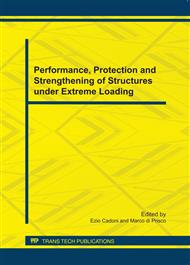p.320
p.326
p.332
p.338
p.344
p.350
p.356
p.362
p.368
Effects of Outrigger Truss Systems on Collapse Initiation Times of High-Rise Towers Exposed to Fire
Abstract:
In this paper, progressive collapse analyses were performed on a 30-story, seven-span tower that was exposed to fire. The Adaptively Shifted Integration (ASI)-Gauss technique was used to demonstrate the effects of fire patterns and structural parameters on collapse initiation time: the duration from the beginning of the fire until collapse initiation. Specifically, an outrigger truss system was placed on the roof of a model, and the influence of the system on the structural vulnerability of the tower was verified. The structural parameters that were varied in the analyses included the axial force ratio, the member joint strength ratio and the member strength ratio of the outrigger trusses to the strength of the beams on the first floor. From the numerical results, it is confirmed that collapse initiation times are significantly affected by the member joint strength ratio if the axial force ratio is small (floor loads are low) on the condition that the fire pattern is nearly symmetrical, and the load paths to and from the outrigger truss system are sufficiently protected.
Info:
Periodical:
Pages:
344-349
Citation:
Online since:
July 2011
Authors:
Price:
Сopyright:
© 2011 Trans Tech Publications Ltd. All Rights Reserved
Share:
Citation:


